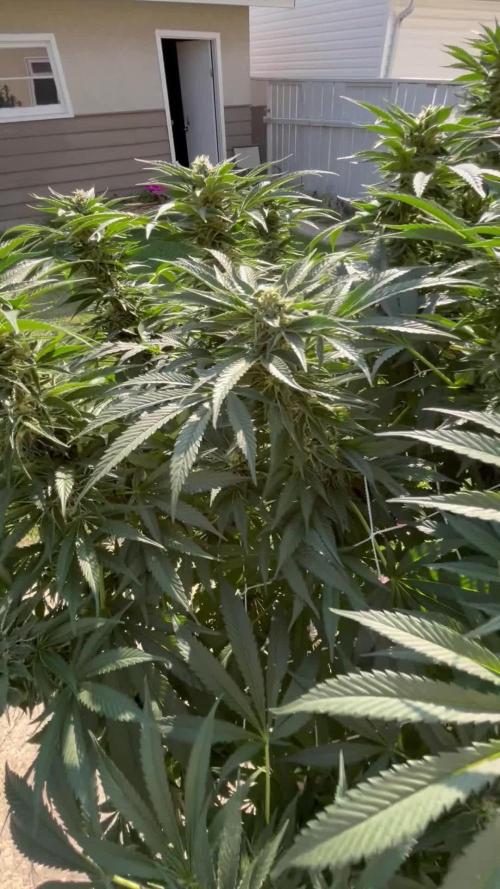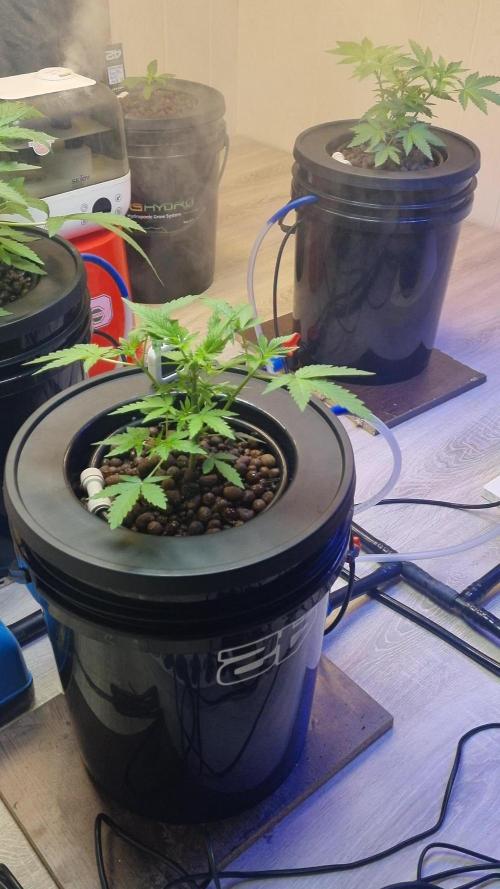The Grow Awards 2026 🏆 







































Likes
Comments
Share


@AltexGrower
Follow
Making the ties and defoliating to the light enter in the center of the plant.
Likes
3
Share


@RezaM
Follow
This week, I gave my plants more fertilizer to test if they show any signs of burning. Now, I'm stressed out! I think I should give myself some seaweed to relieve the stress 😂
The girls show signs of calcium deficiency. I sprayed a small amount of calcium and magnesium on them to help them recover faster. I’m not sure why the new leaves are very pale. Could they be lacking iron? I think the high soil moisture might be causing issues with iron absorption, but I’m not completely sure. I’ll wait and see what happens this week. Considering that I use regular water, I expected them not to have a calcium deficiency.
Likes
25
Share


@Fibro_Witch
Follow
She's changed a lot in the last week and flowers have opened right up!
On 8/1 I got some spent hardwood substrate blocks from a local mushroom farmer and crumbled them around the base of each plant, including the autos. Hoping the mycelium can get in there to work their magic in the last few weeks this girl has, not to say she has anything "wrong" with her, just looking forward to a good harvest!
Other than that, there's not much to report. She was fed & watered 2x this week since we've still been getting consistent rain and I don't want to overwater.
Likes
11
Share


@DesDeGrower
Follow
It’s the time....Luke is now ready to finish his training.
He changed location to much bigger and taller tent for his flowering period.
Everything under MarsHydro TS3000 light 💡
Before switching to 12/12 got quick defoliation and transplanted to final 30l pot 🤘
Tomorrow getting his trellis net #
Keep it locked and stay tuned!
😎🤘
Couldn’t resist and managed to put trellis in place before sleep 😎
🚨 —-> second plant (one on left side) is LemonWalker OG as well from DNA Genetics started in same time as Skywalker. There was some issues with it on early veg stages and to be honest I was almost sure she will not make it.....surprise, surprise as you can see recovered to the point where I decided to switch her to flower and see what she will bring 😉
Day6 update
Girls going both strong 💪 We can see first flowers starting to shape.
Second and probably last defoliation today to push all the power into forming tops 🤘
Stay tuned!
Likes
4
Share


@805homegrown
Follow
Everything is still going good for this week just giving 6.2 PH Tap water with a bubbler for 24 hours before I fill my Reservoir.
July 2 when my lights came back on at 5pm I decided to Defoliate these two girls and add a ScrOG net for some extra support and some tucking for the leaves.
July 6th last day of week 8
I took the other two plants in the back out of the tent today so I can flip these to 12 on 12 off.
Likes
10
Share


@cherokee
Follow
Всем привет 🖖
Бортовой журнал запись 8
Я начну эту запись с того что расскажу вам о трагедии которая произошла сегодня у меня дома 18.02.2023
Первые 2 видео я снимал сам, там не видно языков пламени, не успел заснять этот ужас который я видел.
Было спокойное утро 09.32 часов, как обычно звучала сирена звук воздушной тривоги который звучит каждый день по несколько раз. Я поехал в другой конец города менять документы, мы стояли на парковке с моей девушкой и пили кофе, рядом с нами было десятки людей, и тут мы слышим взрывы ракет. Россия государство терорист эти преступники и убийцы в очередной раз нанесли новый ракетный удар. Это был ужас, сначала упала одна ракета и прозвучал очень сильный громкий взрыв, все люди начали кричать и плакать от страха, спустя минуту прозвучал второй взрыв....... Громкие хлопки и языки пламени поднялись на десятки метров в воздух. Это ужас, это очень страшно, взрывы огонь звуки сирены, кругом крики людей и паника. Русские убийцы стреляют по обычным домам, я хочу что бы каждый кто это читает знал то что россия это террористы которые убивают мирных граждан своими ракетами !!!
В результате обстрела пострадали 3 учебных заведения, несколько жилых домов, 17 автомобилей, раненых....... Ублюдки горите в аду!!!!
🇺🇦 💪 УКРАИНА 💪 🇺🇦 мы победим! СЛАВА УКРАИНЕ!!! ГЕРОЯМ СЛАВА!!!
Дневник.
Мне тяжело вести дневник, кто читает мои записи знает что у меня нет света, нет отопления, на нас падают ракеты......
Растения сладко пахнут, цветы дозревают несмотря на что, много ещё прозрачных трихом которые так и манят своим сладким ароматом. Purple Punch почему-то не меняет свой цвет на пурпурный, немного фиолетового оттенка есть но я надеялся что они будут фиолетовые.
С водой обратного осмоса смешал Delta 9 и Booster это был последний полив удобрениями, дальше только вода.
Я устал пить алкоголь, успокоительное, снотворное что бы уснуть что бы не бояться что меня и мою семью убить, я хочу покурить эти цветы что бы мне стало спокойно. Каннабис меня лечит от тривоги, бессонницы, нервов.
Всем мирного неба 💪🇺🇦 будьте живы и здоровы..... Пока......
Likes
8
Share


@Hippity
Follow
The girls look healthy, happy, and smell delicious, kinda sweet citrusy. I'm overall satisfied so far. They have some crystals forming on them as well. I feel like it's gonna be a successful grow. But don't think I'm gonna use Green-O-Matic again, it's not as short as I wanted it to be, and it has unstable phenotype. I hope the effects are nice and relaxing though.
Likes
28
Share


@Grow_N_Smoke
Follow
Noticed some yellowing tips. I think I need to dial back the nutrients a bit. I increased them last week to see what they could handle.
There is a lot more growth than I expected this time and I've let them veg longer than I usually like to but it was necessary to let them recover from my previous mistakes.
Tomorrow will be a good day to defoliate and start the flip into flower.
If it isn't nutrient burn, then what is causing the yellowing leaves and tips?
Likes
16
Share


@Northern_Ent
Follow
Sep 6: Lemon Cream Kush is shaping up nicely. Buds are starting to thicken up and get frosty. Might be a bit of a P deficiency going on but I dont want to over fertilize this late in the grow.
Sep 7: one last round of malted barley and Power Bloom. Leaves seemed a bit too blue indicating P deficiency so another round of bloom nutes were applied..
Likes
79
Share


@bioaccessory
Follow
И это всё FastBuds! 😜В этот цикл у моих автоцветов случился полный рассинхрон. Вы только посмотрите👆 - лимонад вымахал выше метра(что еще раз доказывает, что в ограниченном пространстве нужно применять техники по сдерживанию роста), и уже сформировал красивые одуваны, также цветет 20:1. У cbd crack пока нет даже намека на цветение. Самое позднее время зацветания автоцвета в моей практике - на 53день, посмотрим, будет ли побит рекорд. Хоть и не хочется, но видимо придется перейти на раздельное питание.
А пока сделал перестановку, и теперь смог согнуть лимонад, надеюсь его рост прекратился. Т.к. в дальнейшем лазить в бокс будет уж проблематично, таки подсоединил фильтр(еще цикл без замены угля😱). Включил боковой досвет.
Ах да, в начале недели лимонад проявил фиолетовый фено, вот так резко, прямо на глазах в течении дня.
Спасибо, что заглянули, и будьте здоровы! 🙏
Продолжение следует...😶
Likes
8
Share


@MrWeedWorld
Follow
Diese Woche ein bisschen die großen Blätter ausgeschnitten das die Triebe mehr Licht bekommen.
Likes
14
Share


@oxieg3ngrows
Follow
What can I say that the journal doesn't already. A massive yield for a 1ftx1ft area in my 4x4 tent. Tons of frost. Sticky as possibly can be (my scissors hate me, but love acetone today)
Processing
Likes
2
Share


@Firepharmer
Follow
Day 43 ,
6 and a half weeks . She started to cloud up and has a few amber trichomes . Buds as starting to really full out now
Likes
35
Share


@XxxAuto
Follow
Again thanks too Fastbuds, for this amazing strain.... it's SOOOOOOOO fucking good !!!!!!!! 😘😍 and a beautiful lady
Likes
3
Share


@MotasKush
Follow
Sunset Sherbet x Purple Punch from Ripper seeds. 👑🔥Low stress training 🙌😁, happy healthy plants... . Grow Your Own! 💚🍁💚 Love Cali strains, purple buds And trichomcity. 💜🤩😍
Likes
13
Share


@GrowinMyOwn
Follow
Update 11/8...2nd plant is harvested and jarred. The terps on this strain are amazing!
I harvested only 1 plant....her sister (the tall purple girl) is still under the lights. Based on dry weight on 4 upper colas harvested 5 days earlier I'm expecting a whopping 160 grams from just the one plant. The colas are super frosty and dense, holding their weight during drying. I've got 40 grams already curing, the rest is still hanging in the dry box. This strain was an absolute pleasure to grow and even an uncured bud smokes smooth and sweet with a nice, even slow burn and white to light grey ash. It's gonna be my go-to from my winter stash line-up!!
Thank you Royal Queen Seeds for the opportunity to select and grow one of your strains and for Organic nute setup. It's obvious I snagged an excellent strain grown with topnotch nutrition. I've got 3 more Green Gelato beans and can't wait to pop em next grow.
Likes
154
Share


@CBD_Sweden
Follow
@FAST_BUDS,
Hi all the happy people here in GrowDiaries.
This is my second cultivation ever and it will be fun to try a bigger space than my closet grow.
First, I'm just going to say I'm done with the construction of my new growroom.
I put some pictures on the construction here in week one.
The room is 2.14 meters by 1.7 meters and has a ceiling height of 2 meters.
It provides a floor area of 3.6 square meters.
I use a 54 Watt Lightwawe T5 for germination and 2 Pcs 400 Watt HPS lamps.
I have a channel fan that replaces the room air about 40 times an hour to get a comfortable environment in the room, the air enters a fresh air intake from the outside.
The air is purified through a carbon filter to then leave the room to the rest of the basement.
Then I use that heat to heat the rest of the basement.
I will use 8 pcs 15 liter Autopots to grow with and a 100 liter water tank that supplies the pots of water and nutrition.
I will grow completely organically in soil and will watercure my buds to get the best possible medicine for me.
But there are no cultivation rooms to be displayed here, so I continue with what is most important.
Today I have put my seeds in my moisture dome and hope the seeds have germinated within a few days.
I am very excited to see how the new growroom will work and how this new secret CBD plant from @FAST_BUDS, will turn out.
..............................................................................................................................................................................................................................................................................................................................................
2017-09-11. Kl 12.00. Week 4 starts. I have cleaned the whole room for the new week and gave the girls water and nutes. Added videos and pics. Girl nr 1 is 27 cm high and girl nr 2 is 22 cm high.
-----------------------------------------------------------------------------------------
2017-09-12. Kl 10.00. New pics and video. Girl Nr1 has grown 5 cm in 23 hours, from 27 to 32 cm.😍
-------------------------------------------------------------------------------------
2017-09-13. Kl 22.00. Everything is looking great in the garden right now. Added new video.
--------------------------------------------------------------------------------------------------
2017-09-15. KL 10.00. New video added. Girls are looking great and they got 3 liters of water and nutes this morning. Girl Nr 1 is 38 cm high and Nr 2 is 28.
-----------------------------------------------------------------------------------------------------------------------------------------------------------------------------
2017-09-16. Kl 10.00. The girls grow like crazy, i have to defoliate about 20 leafs a day. Added 2 liters of water and nutes this morning and 2 new videos.
-------------------------------------------------------------------------------------------------------------
2017-09-17. This is the last day of week 4. Added a time laps from germ to week 4.
Likes
14
Share


@BudXs
Follow
Ya boii, you know the ABC sound!
Playground
Coming from the playground take it straight back to the streets
You know what it is
Well im Roro coming in third
Nows about that time that i get heard,
None of my rhymes have ever ever been heard
Word to herb play tricks on ya mind, a come on
Everybody here is real superb, and ill be right back with part 2 of rhis funky rhyme , B , ya...
Yo red, i dont wanna flow no more man, yall go aheadz im just gonna sit back on this bad old beat
Cuz this is what i do
At the playground
Likes
26
Share


@DreamIT
Follow
Sponsored by:
🏡GANJA FARMER SEEDS🏡-💡VIPARSPECTRA💡-💐GREEN BUZZ LIQUIDS💐-🛠️WEDRYER🛠️
28/7 all right, soon cutting, cloning and flowering
2/8 I'm not a good grower, as evidenced by the fact that I left this delight in a corner for almost a week. It was wedged between other plants and not enough light passed between the branches, moreover, the same nourishment did not arrive as it did to the other plants because it was also a bit crooked. I recover with a bit of N and let's see how it behaves in flowering
__________________________________________
Personal advertising (contains affiliate links)
__________________________________________
🦄 Huge collection of exquisite genetics since 2009! Anonymous shipping!
✅https: //bit.ly/Ganjafarmer
__________________________________________
Did you know that Green Buzz Liquids fertilizers are 100% vegan? A complete line of products ready to give the best to each of your plants! Visit the site and see my journals to see how they work 🦄
🤯 And with the code "dreami t" you will immediately receive a 15% discount on your purchases
✅https: //bit.ly/GreenBuzzLiquidsPro
__________________________________________
👀 Are you looking for a good lamp to start with? 👀
🌞Viparspectra has something more than the others, take a look at their site.
⏩ Use "GDVIP" for an extra discount or "DREAMIT3" for an extra 5 %% discount
👀 Search for it on Amazon
✅Amazon USA: https://amzn.to/30xSTVq
✅Amazon Canada: https://amzn.to/38udUVe
✅Viparspectra UE: bit.ly/ViparspectraUE
✅Viparspectra USA: bit.ly/ViparspectraUS
______________________________________________
🌈 Tired of blowing on your weed hoping it dries quickly? Check out the Wedryer website! You will find a well-made accessory that will help your weed dry in just 8-10 days without the annoying risk of finding mold or other annoyances! (no affiliate links)
✅https: //bit.ly/Wedryer_
______________________________________________
📷🥇Follow the best photos on Instagram 🥇📷
https://www.instagram.com/dreamit420/
Backup
https://www.instagram.com/dreamit4200/
🔻🔻Leave a comment with your opinion if you pass by here🔻🔻
🤟🦄💚 Thank you and good growth 💚🦄🤟
Likes
121
Share


@Cruzsider
Follow
420 is always fun to grow, partly cause I know what to expect.
QUALITY!
I'll be back with more information 😌 and













